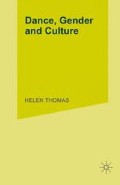Abstract
Recent feminist scholarship on the social and cultural construction of gender and equity enables us to assess the implications worldwide of historically persistent male dominance in dance production.1 In India a key understanding of the reality of women’s subordinate status comes from the traditional and mythical portrayals of women (Ghadially, 1988), some of which are restated in dance.2
Access this chapter
Tax calculation will be finalised at checkout
Purchases are for personal use only
Preview
Unable to display preview. Download preview PDF.
Bibliography
A. Bandura, ‘Modeling Theory: Some Traditions, Trends, and Disputes’, in R. D. Park (ed.), Recent Trends in Social Learning Theory (New York: Academic Press, 1972), pp. 35–61.
P. Banerji, Erotica in Indian Dance (Atlantic Highland, NJ: Humanities Press, 1983).
Bharata Muni, see Ghosh.
F. Bowers, The Dance in India (New York: Columbia University Press, 1953).
M. Chaki-Sircar, ‘Community of Dancers in Calcutta’, in S. Sinha (ed.), Cultural Profile of Calcutta (Calcutta: Indian Anthropological Society, 1972), pp. 190–8.
M. Chaki-Sircar, Feminism in a Traditional Society: Women of the Manipur Valley (New Delhi: Shakti Books, 1984a).
M. Chaki-Sircar, ‘Rabindra Dance Drama in Modern Times’, in R. Biswas (ed.), On Tagore (New York: Tagore Society of New York, 1984b), pp. 19–24.
M. Chaki-Sircar, and P. K. Sircar, ‘Indian Dance: Classical Unity and Regional Variation’, in A. G. Noble and A. K. Dutt (eds), India: Cultural Patterns and Processes (Boulder, Colo.: Westview Press, 1982), pp. 147–64.
S. Chitnis, ‘Feminism: Indian Ethos and Indian Convictions’, in R. Ghadially (ed.), Women in Indian Society (New Delhi/Newbury Park: Sage Publications, 1988), pp. 81–95.
W. Claiborne, ‘Dowry Killings Show Social Stress in India’, Washington Post (September 22, 1984), p. 1.
J. Cunningham, ‘Classical Dance of India in Canada: Adaptation, Play and Women’, PhD dissertation (William Lyon University, 1992).
A. de Souza, Women in Contemporary India and South Asia (New Delhi: Manohar, 1980).
V. Dhruvarajan, Hindu Women and The Power of Ideology (Granby, Mass.: Bergin and Garvey, 1989).
M. I. Duley, and M. Edwards (eds), Cross-cultural Study of Women (New York: Feminist Press, 1986).
J. L. Erdman, ‘Who Should Speak for the Performing Arts? The Case of the Delhi Dancers’, Pacific Affairs 56 (20) (1983) pp. 247–69.
A-M. Gaston, Siva in Dance, Myth and Iconography (Oxford: Oxford University Press, 1982).
A-M. Gaston, ‘The Effect of Changing Social Structures in Indian Classical Dance’, in Contributions to the Sociology of the Arts: Reports from the 10th World Congress of Sociology, Mexico City, 1982 (Sophia, Bulgaria: Research Institute for Culture, 1983), pp. 197–308.
L. E. Gatwood, Devi and the Spouse Goddess: Women, Sexuality, and Marriages in India (Riverdale, Md.: Riverdale, 1985).
R. Ghadially, (ed.), Women in Indian Society (New Delhi/Newbury Park: Sage Publications, 1988).
M. G. Ghosh (trans.), Nayasastra (Calcutta: Royal Asiatic Society of Bengal, 1950).
J. L. Hanna, The Performer-Audience Connection: Emotion to Metaphor in Dance and Society (Austin: University of Texas, 1983).
J. L. Hanna, To Dance is Human: A Theory of Nonverbal Communication, reprint of 1979 with new foreword (Chicago: University of Chicago Press, 1987).
J. L. Hanna, Dance, Sex, and Gender: Signs of Identiy, Dominance, Defiance, and Desire (Chicago: University of Chicago Press, 1988a).
J. L. Hanna, Dance and Stress (New York: AMS Press, 1988b).
J. L. Hanna, ‘Dance and Women’s Protest in Nigeria and the United States’, in G. West and R. L. Blumberg (eds), Women and Social Protest (New York: Oxford University Press, 1990), pp. 333–45.
J. L. Hanna, ‘Feminist Perspectives on Classical Indian Dance: Divine Sexuality, Prostitution, and Erotic Fantasy’, in D. Waterhouse (ed.) Dance of India (University of Toronto Graduate Centre for South Asian Studies, 1992).
S. Hazarika, ‘Past Threatens Future of Indian Women’, New York Times (6 January 1981), p. E24.
S. Hazarika, ‘Age-Old Hindu Barrier Falls: Women are Priests’, New York Times (3 July 1984), p. A2.
F. Henriques, Prostitution and Society: A Survey (New York: Citadel Press, 1962).
A. M. Jaggar, Feminist Politics and Human Nature (Totowa, NJ: Rowman and Allanheld, 1983).
R. Jeanes-Antze, ‘The World of Indian Dance’, Dance in Canada (August 1979), PP 5–9.
R. Jeanes-Antze, ‘Tradition and Learning in Odissi Dance of India: Guru-Sisya-Parampara’, MFA Dance History and Criticism (Toronto: York University, 1982).
M. Khokar, ‘Bharata Natyam and Kuchipudi’ (Mimeograph n.d.).
M. Khokar, Traditions of Classical Indian Dance, rev. and enlarged 1979 edn (New Delhi: Clarion Books, 1984).
S. Kothari, ‘Gotipua Dancers of Orissa’, Sangeet Natak, 8 (1968), pp. 31–43.
K. L’Armand, and A. L’Armand, ‘One Hundred Years of Music in Madras: A Case Study in Secondary Urbanization’, Ethnomusicology, 27 (3) (1983) 411–38.
S. Nanda, ‘The Hijras of India: A Preliminary Report’, Medicine and Law, 3 (1984) 59–74.
G. A. Oddie, Social Protest in India: British Protestant Missionaries and Social Reforms 1850–1900 (New Delhi: Manohar, 1979).
W. D. O’Flaherty, Women, Androgynes, and Other Mythical Beasts (Chicago: University of Chicago Press, 1980).
V. T. Oldenburg, The Making of Colonial Lucknow, 1856–1877 (Princeton: Princeton University Press, 1984).
R. Puri, ‘New Directions in Indian Dance’, India Magazine (June 1986), pp. 36–43.
V. A. Rao, ‘Kuchipudi School of Dancing’, Sangeet Natak Akademi Bulletin, No. 11–12 (April 1959), pp. 1–8.
J. Raymond, Transsexual Empire (Boston: Beacon Press, 1979).
M. Roy, Bengali Women (Chicago: University of Chicago Press, 1972).
M. Sarabhai, The Eight Nayikas: Heroines of the Classical Dance of India, Dance Perspectives, No. 24 (1965).
M. Sarabhai, Longing for the Beloved: Songs to Siva-Nataraja in Bharata Natyam (Gujarat: Durpana, 1976).
K. Vatsyayan, Classical Indian Dance in Literature and the Arts (New Delhi: Sangeet Natak Akademi, 1968).
Editor information
Editors and Affiliations
Copyright information
© 1993 Palgrave Macmillan, a division of Macmillan Publishers Limited
About this chapter
Cite this chapter
Hanna, J.L. (1993). Classical Indian Dance and Women’s Status. In: Thomas, H. (eds) Dance, Gender and Culture. Palgrave Macmillan, London. https://doi.org/10.1007/978-1-349-22747-1_8
Download citation
DOI: https://doi.org/10.1007/978-1-349-22747-1_8
Publisher Name: Palgrave Macmillan, London
Print ISBN: 978-1-349-22749-5
Online ISBN: 978-1-349-22747-1
eBook Packages: Palgrave Social & Cultural Studies CollectionSocial Sciences (R0)

